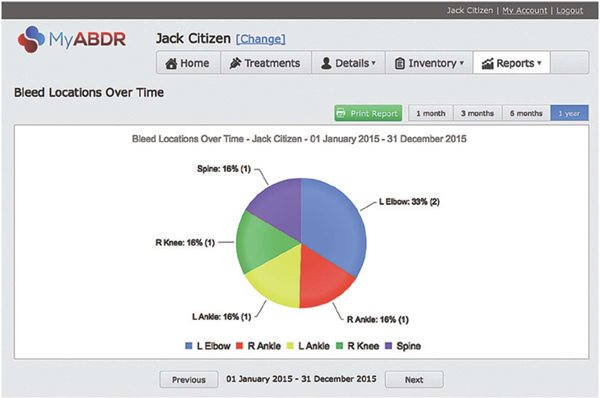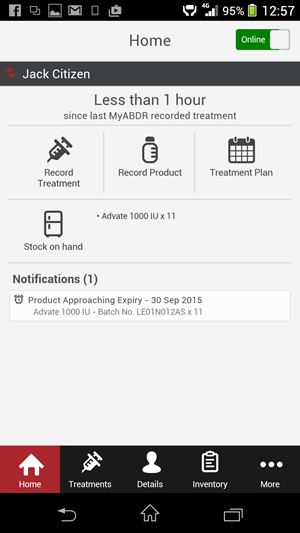SUZANNE O'CALLAGHAN
Suzanne O’Callaghan is HFA Policy Research and Education Manager
In my education work on MyABDR, the discussion about why you should bother recording with MyABDR comes up regularly, particularly with young people. With their busy lives, dealing with their regular prophylaxis treatment or treating a bleed can feel like enough of an intrusion into their life, let alone recording it as well. So why is there so much emphasis on the need to record?
MyABDR was developed as a tool to support best practice clinical care and treatment of people with bleeding disorders. What does this mean?
MyABDR is a secure app and web site that allows people with bleeding disorders and parents/caregivers to record treatments and bleeds at home and manage their treatment product inventory. It links directly to the Australian Bleeding Disorders Registry (ABDR), which is the system used nationally by Haemophilia Treatment Centres for the clinical care of their patients. However, protection of the individual’s privacy is critical to the system and the only data about them, their bleeds and treatment made available outside of the person’s Haemophilia Treatment Centre (HTC) are de-identified statistics.
There was enormous excitement when MyABDR was established and released in early 2014. MyABDR is a collaboration between HFA, the Australian Haemophilia Centre Director’s Organisation (AHCDO) and the National Blood Authority (NBA) on behalf of Australian governments – all the key players in the treatment and care of someone with a bleeding disorder: the patient, the Haemophilia Treatment Centre, the NBA which is the government authority that purchases and supplies treatment product, and the governments that pay for it.
So how does recording with MyABDR actually help best practice treatment and care?
One of MyABDR’s most important roles is to document instantly your or your child’s bleeds and treatments and to link that into the national ABDR system that is used by your HTC. How is your treatment plan going? Are you having bleeds? If so, how often, where, how is this related to your treatment? Does your treatment plan need to be adjusted?
Whenever you or your HTC want to look over your treatment and bleed history, MyABDR has a suite of online reports and lists that both you and your HTC can consult, if you have been recording:

Neil, who has severe haemophilia, has found this to be very important to his care.
“I have found MyABDR valuable to keep track of my bleeding episodes, how often I have one, and exactly where they occur – to see any target sites, eg elbow, ankle, knee. Without MyABDR, if I don’t remember to record it in a diary, I forget and it’s gone.
“When I do have my regular reviews with the HTC, the haematologist and I are on the same page. He has my MyABDR data in front of him. Before MyABDR, getting my information on the number of bleeds I’ve had and the amount of product to treat a bleed was very rare.”
Neil has made recording a habit.
“It’s one of those things I do straight after I’ve had the treatment, and also when I receive my new stocks of factor VIII, I record my stocks and then put the vials in the fridge. That’s how easy it is. The product doesn’t have to sit out of the fridge for a long time while I work out how to record it, because the system is so easy and quick to use.”
Having your treatment product inventory in MyABDR means that you can have your stock records at your fingertips – on your smartphone and your home computer. If your HTC or the product supplier contact you to see whether you need more stock, you don’t have to look in the fridge to see how much you have left.
On the broader level, treatment stock usage patterns are immensely important. Overall statistics about the amount and types of product being used can help the government to stocktake and plan for purchase of future supplies. Anyone who recalls the treatment product shortages that were common thirty years ago knows how crucial this is. Treatment product is a precious commodity: it is lifesaving and can prevent bleeding complications like arthritis in joints; and it is also very expensive. Careful planning and purchasing agreements are essential for our national government, especially when they are accountable to all Australians for their actions.

The 2016 World Congress highlighted many of the new innovations in treatment – for example, longer acting factors treatments that mean treatments do not have to be infused as often; and another treatment for haemophilia A that can be injected under the skin rather than into veins and has a novel approach to creating clotting.
To have access to these kinds of treatments in Australia, we will need to make a case for them, based on evidence. How do we compare them with treatments currently used in Australia? MyABDR is an obvious tool for creating real world data on this. The treatments and bleeds that each individual records can become part of the national de-identified statistics to show how a particular treatment works, including in individualised treatment regimens, and their impact on bleeding patterns. This is not only an effective way to understand and improve current treatments; it is a very valuable resource for our advocacy for future treatments.
For Neil, this aspect of MyABDR is another driving force for recording:
“MyABDR provides the Treatment Centre and relevant government agencies with the type of data required to provide people with bleeding disorders improved treatment and care. With these statistics in front of them they are more informed about the importance of these products to people with haemophilia and other bleeding disorders.
“It is at the ‘end of the chain’ that, in my opinion, the real value of MyABDR exists for people with bleeding disorders and for this reason the more it is used the better. MyABDR provides us with the opportunity to influence our level of treatment and the availability of improved factor.”
AHCDO can use aggregated statistics to help answer questions about treatment and treatment outcomes. HFA has been eager to see what these reports can tell us and their potential to improve patient care.
However, bleeding disorders are rare and comprehensive data is needed from as many patients as possible to make meaningful results. While there are close to 700 registered MyABDR users, we are aware that quite a few registered users do not record regularly. We are looking into why this is an issue and ways to increase recording and ease of use. If you have any thoughts or experiences relating to this, please feel free to contact HFA and tell us about it! You can email or phone us, or use the online MyABDR feedback form – tinyurl.com/myabdr-feedback .
HFA’s mission is to aspire to world’s best practice in relation to treatment and care. This is reliant on the kind of evidence-based data that could be built through MyABDR and we will continue to work with the community, AHCDO and the NBA to achieve this.
Haemophilia Foundation Australia acknowledges the Traditional Owners and Custodians of Country throughout Australia, the land, waters and community where we walk, live, meet and work. We pay our respects to Elders past and present and extend that respect to all Aboriginal and Torres Strait Islander peoples.
Sign up for the latest news, events and our free National Haemophilia magazine